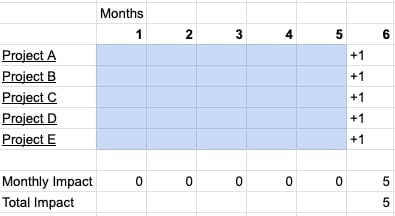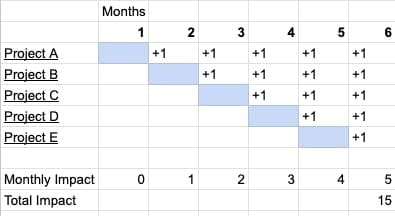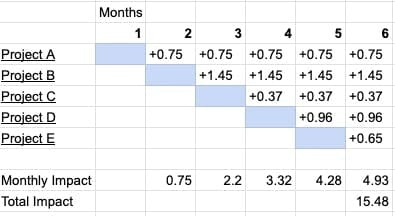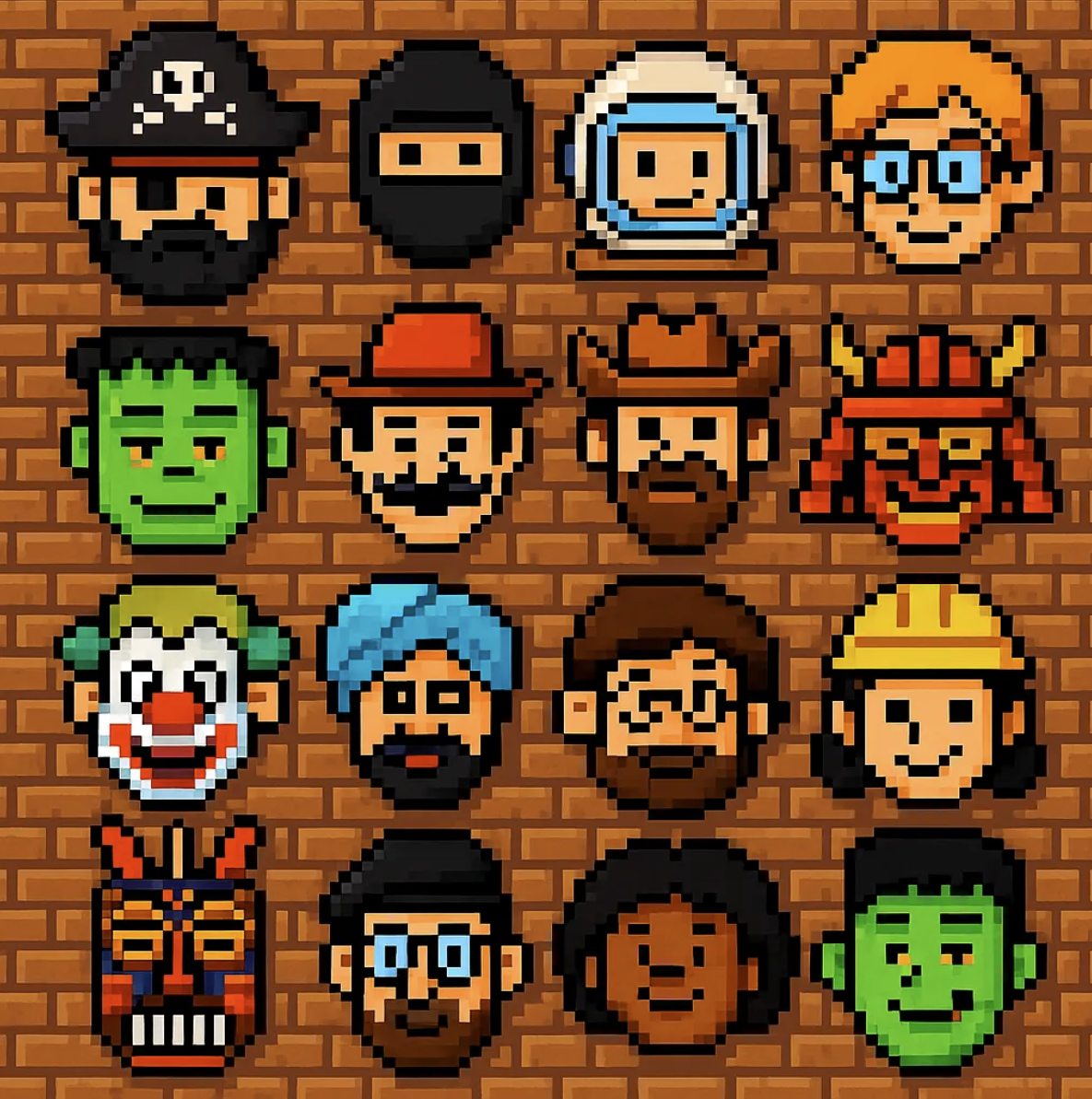
One of the hardest parts of any job is separating yourself from the day-to-day chaos to figure out if you’re working on the right things.
It's very easy to just “go with the flow”; however, due to the compounding nature of subscription businesses, the order in which you launch things can make a huge difference.
The majority of companies start the quarter, kick off all of the work that they have to do, and then hope to launch everything before the time is up.
Let's assume that you’re running a team that has 5 projects and are working on them across a 6 month period. Each of them drives 1 point of value for the company, and you have an OKR to add 5 points.
Leadership really wants you to get moving on the big projects, so you kick everything off, and the engineers start working. If everything goes well, you can launch everything before month 6 and hit your goals.

Working like this makes the team “feel” really busy and look great in project update meetings. Their project tracker shows that you have a lot going on and that you are making progress on everything.
The downside to this approach, as you can probably guess, is that you aren’t actually moving the business while these projects are being built. Projects only produce value when they are released.
The alternative approach is to throw more resources into each project to get it done faster.

There are many reasons that this is harder in reality (more engineers on a project doesn’t necessarily mean it goes faster, there are dependencies on other teams, etc.), but the principle holds. Focusing your resources will get your projects shipped faster.
If you are using this “simple” accounting method for goals, it looks like this approach produces a similar result. 5 products x 1 point each = 5 points of value.
However, this is not how it actually works. Wins in subscription products compound each month, so you need to start banking wins as fast as possible while you work on the bigger challenges.
Across all business types, but especially in subscription products, time is a huge factor.

Project Risk
Drilling into this example a bit further, what makes sequencing hard is that you don’t know what each project will do when you build it.
In our example, each project adds 1 “point” of value, but in reality, you’ll never know exactly how much you’ll increase a metric.

You will have projects that are duds, some surprising winners, and some that did pretty much what you thought. Because of this variability, controlling for risk and maximizing speed becomes even more important.
If you thought a project would take 3 months and produce 2 points of “value,” and it actually takes 5 months and produces 0.35 points of value, you are in a lot of trouble.
Do this multiple times, and this is how product managers get fired.
Risk is driven by any form of uncertainty factors, such as:
Engineers working on a new part of the codebase they don’t understand yet
Developing features for a new user persona
Moving up or down market to a new customer base
Implementing a new technology or vendor
Trying to update your company messaging or value prop
You can mitigate each of these risks by conducting additional research, usability testing, conducting good headroom analysis, breaking projects into phases, etc.
However, each mitigating step adds more cost/time to the project, which also delays the value. Ideally you are starting with the projects that don't need risk mitigation,.
A Simple Framework - Bottom-Up Optimization
Because time is so important in subscription products you want to find the most reliable wins that you can launch as fast as possible.
The more you increase MRR this month, the stronger your start will be next month and the month after that, etc.
This approach has 2 components:
Where to focus?
What to focus on?
Said another way, you want to find projects that are:
Easy to define requirements for
Impact most of the revenue base
Fast to ship
Have minimal uncertainty
Caveat: This is what I would call a “vanilla” scenario, where there are no large burning fires anywhere in the business. E.g if your checkout page breaks on mobile, you have to start there and fix that.
Where: Start at the Bottom and Work Up
Months ago, we covered the 5 core layers of subscription products, which are the building blocks of how your monetization system works:
Paywall & Pricing Structure
Purchase flow
LTV Extension Tactics
Payment Processing
Cancelation Flow
Working bottom up means that you would first start working on the cancelation flow, then payment processing, and moving up from there.
There are a few reasons to do this:
Best practices are much clearer at the bottom - Cancelation flows and payment processing tactics are nearly universal across product categories. Paywalls are not. The clearer the best practices, the less product development you have to do, and the faster you can ship.
Improving the “deeper” layers of the product impact more of the users base - Reducing churn by improving payment processing impacts 100% of your paying users, where as improving free to paid conversion will only impact your new revenue each month, which is a fraction of total revenue.
The bottom layers typically (but not always) involve fewer stakeholders and less technical complexity - Changing pricing will involve aligning a lot of people and probably a lot of engineering work. Upgrading your cancelation flow doesn’t, and there is likely no one looking at it at all.
You might as well bank the wins from lowering churn a bit while you spend a few months researching and dialing in your paywall.
What: Quality → Clarity → Best Practices → Sparkles
Once you pick a place to focus, ideally starting at the bottom, within that layer, you want to move from the least risky kind of project to the most risky.
I would (roughly) sequence these projects like this:
Quality - What is broken? What looks broken? What is not functioning as it was originally designed?
Clarity - Where are users confused within you existing flow? Does the user know what they are supposed to be doing at every part of the app? Are you describing your paid product clearly? Is there excessive friction in a key part?
Best Practices - are you following the best practices in each area?
Sparkles - These are the custom features that take your product to the next level. They can unlock a lot of value, but it is much harder to get right.
Nailing 1, 2, and 3 across all layers of the business will have a much bigger impact than you think.
So What Do You Do With This Information?
The larger a company that you work at, the harder it is to resist the “momentum” to spread your resources across multiple projects that impact multiple parts of the app at once.
This isn’t a battle that you are likely to “win”; it is more of one in which you can make more and more progress each time you build a roadmap.
If you are the founder of a company, especially an early stage one, using this approach early on can set you up to have a strong foundation for growth for years ahead of you.





